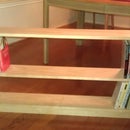Introduction: DIY Routing Table
This Instructable describes a routing table I made at Techshop after taking the Laser Cutter SBU.
I wanted a project to try out my new laser cutting skills, and a router mounting plate for a router table seemed perfect. Techshop has a nice router table that members can use, but I have a lot a small projects in my garage, so my own table at home would come in handy.
In this instructable, I describe all the tools and materials you need to construct your own.
If you'd like to obtain the design files, they are located on GitHub at https://github.com/wwashington/DIY-Routing-Table.git
For more information about TechShop go to http://www.techshop.ws
Step 1: Routing Table Tools and Materials
To build the router table you will need the following tools:
* Router
* Router Speed Controller (optional)
* 3/4" Countersink Bit
* 1/2" Height Rabetting Router Bit
* 5/16" Drill Bit
* 3/4" Forstner Bit
* Jigsaw
* And of course, access to a Laser Cutter
You will also need the following materials:
* Acrylic Sheet (at least 1/4" thick and 8 1/2" x 11")
* Three or Four Router Mounting Bolts (The size depends on your router. My router required three 5/16-18 bolts.)
* 3/4" Plywood 24" x 24" (I used birch.)
* Eight 5/16 Carriage Bolts, Split Washer and Lock Nuts
* Tool Stand Kit
* Cable Ties
Step 2: Routing Face Plate Design
The design of the router face plate will vary based on your particular router, so please consider these instructions as guidelines and make the appropriate changes for your router.
You do not want to make the face plate too big or too small. It should be a little larger than the hole in the table, and the hole in the table should be just big enough for your router to slide in diagonally. My router needed about a 11 1/4" diagonal hole to fit through the table. The dimensions on the hole are 6 3/4" X 9 1/4".
Next, you will need to add a border around the hole. This forms the outer dimension of the face plate. My rabetting bit is 3/4" in diameter and contains a bearing that cuts a 3/8" edge. Therefore, the overall dimension of my face plate are 7 1/2" (6 3/8" + 3/8" + 3/8") X 10" (9 1/4" + 3/8" + 3/8"). The corners of the face plate have a radius of 3/4".
In the center of the face place, put a 1 1/2" diameter hole for the router bit. Relative to this hole, determine the location of the router mounting holes.
Finally, I added a 1/4" hole for a installing an optional post that is used to help steady the work for some routing jobs.
After you calculated all these dimensions, you are ready to create a drawing of your face plate in CorelDraw. To get you started, I included my CorelDraw and PDF files with this instructable.
When you are finished with the drawing output the file to the laser cutter.
Step 3: Routing Face Plate Build
After the router face plate is cut. You will need to countersink the router mounting holes so the screws are flush with the surface. When countersinking acrylic, the drill speed should be less that 500 rpm to prevent the acrylic from melting.
Step 4: Routing Table Stand
Originally, I planned to design and build the stand to support the router tabletop, but I decided it was cheaper and faster to buy an Universal Table Stand from Harbor Freight. They come in a variety of sizes.
Follow the assembly instructions that come with the stand and bulid the table.
Step 5: Attach the Routing Tabletop to the Stand
After the stand is assembled, center the stand on the 3/4" plywood tabletop and mark the mounting holes.
Next, using the 3/4" Forstner bit, countersink the holes approximately 1/8".
Drill 5/16" holes for the carriage bolts.
Finally, mount the top to the stand.
Step 6: Cut the Router Face Plate Hole
Now that the top is mounted to the stand, draw the router face plate on the table surface.
Next, cut out the inner rectangle using a jigsaw.
And finally, use the rabetting bit and router to cut the edge to hold the face place. Adjust to depth of the cut, so the top of the face place is flush with the tabletop.
Step 7: Final Assembly
Attach the acrylic router face plate to the router and insert them into the tabletop. If your router has a trigger instead of an on/off switch, use a cable tie to hold the trigger closed.
I used a router speed controller as an on/off switch and speed control for the router. I mounted the controller to the underside of the tabletop using Velcro. I plugged the router into the speed controller, and used a few more cable ties to tidy up the cords.
NOTE: If you do not use a speed controller, use another method to turn on and off your router easily and quickly.
The router table is complete!














